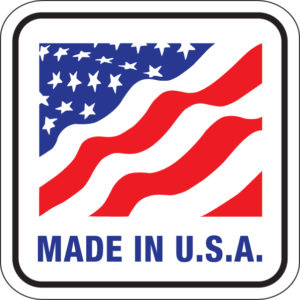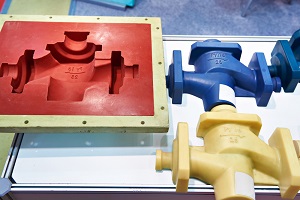Made in USA or Assembled in USA? It Depends.
 Before a manufacturer labels a product “Made in USA” or “Assembled in USA,” it is important to be sure the product meets federal and state regulations for labeling. Unfortunately, the regulations can be vague, complicated and subject to interpretation.
Before a manufacturer labels a product “Made in USA” or “Assembled in USA,” it is important to be sure the product meets federal and state regulations for labeling. Unfortunately, the regulations can be vague, complicated and subject to interpretation.
The Federal Trade Commission (FTC) oversees the federal regulations to prevent companies from false advertising of overseas production and deceptive trade practices.
- Federal Trade Commission oversees “Truth in Advertising” regulations including promotion or disclosure of products displaying “Made in USA” labeling
- FTC requires products advertised as “Made in USA” be “all or virtually all” made in the U.S. “all or virtually all” means the product should contain no – or negligible – foreign content
- Manufacturers use the cost of goods sold or inventory costs of finished goods in their analysis – total cost of all manufacturing materials, direct manufacturing labor, and manufacturing overhead
- For a product to be considered “all or virtually all” made in the United States, the final assembly or processing of the product must also take place in the United States
So how is “all or virtually all” defined? It depends.
Our manufacturing industry research covers this controversial topic and we found that most interpretations of “all or virtually all” means that more than 95% of the value of product parts, labor, and overhead is the typical measure. This means that you would have to look at the detailed bill of materials and validate that every supplier part was manufactured, mined, or grown in the US.
This is no trivial task. Asking your suppliers where every component was manufactured and every component material was sourced, can be daunting – akin to Conflict Minerals investigations. Yet the federal regulations require this.
To complicate matters even more, each state has its own set of labeling requirements that may conflict with the FTC regulations. For example, until 2016, California required “Made in USA” products to be 100% US components and labor. The new law requires 95%
If you follow fashion, you have likely heard of high-end Citizens of Humanity jeans. Citizens of Humanity proudly touts their jeans as “Made in USA,” and sell their jeans for about $200. But are they really made in the USA? According to the California state law, no. According to federal law, yes. A class action lawsuit is currently in the hands of California courts, so we may have to wait and see.
Or perhaps you have heard a similar controversy with New Balance shoes. New Balance labels its shoes “Made in America” even though it admits only 70% is domestic value. New Balance battled the FTC for several years over labeling and settled only a small piece of the law suit. Investigations by the FTC are on-going. A new class action law suit was filed in March 2016 against Nordstrom and New Balance for shoes sold in California, claiming that the retailer was equally responsible for truth in advertising on labels.
Walmart.com used to have an entire section with “Made in USA” products. But based on some questionable product labels, the section on line is now gone.
The controversy is around truth in advertising. Consumers say that if a product is labeled “Made in the USA,” they expect all parts and labor are of American origin. But in the case of Citizens of Humanity jeans, some components came from China. So perhaps a more accurate label would have read “Assembled in USA.”
Have you noticed the labeling on Apple products? The tiny box label says “Designed by Apple in Cupertino, CA; Made in China.”
A new bill recently introduced in the Senate, Reinforcing American-Made Products Act of 2017 (S.118), also known as RAMPARTS, would establish the FTC as the sole authority to define and enforce the “Made in the USA” standard so that a product can carry a consistent label in all 50 states. This law, if passed, would supersede all individual state laws and definitions, and provide clear authority over labeling.
Ultimately, we believe the consumer is entitled to the truth. If not all of the component parts come from the USA, we encourage our Reshoring Institute clients to use labels that say: “Assembled in the USA from foreign components,” or “Assembled in the USA with 85% American-made components” or “Final assembly in America.” These are examples of some the critical decisions that must be made when considering a manufacturing reshoring project.
We encourage companies to be as transparent and truthful as possible, so they don’t end up in court.
About the Author
 Ms. Coates is the Executive Director of the Reshoring Institute and the President of Blue Silk Consulting, a Global Supply Chain consulting firm. She is a best-selling author of: 42 Rules for Sourcing and Manufacturing in China and Legal Blacksmith – How to Avoid and Defend Supply Chain Disputes Ms. Coates lives in Silicon Valley and has worked with over 80 clients worldwide. She is also an Expert Witness for legal cases involving global supply chain matters. She is passionate about Reshoring.
Ms. Coates is the Executive Director of the Reshoring Institute and the President of Blue Silk Consulting, a Global Supply Chain consulting firm. She is a best-selling author of: 42 Rules for Sourcing and Manufacturing in China and Legal Blacksmith – How to Avoid and Defend Supply Chain Disputes Ms. Coates lives in Silicon Valley and has worked with over 80 clients worldwide. She is also an Expert Witness for legal cases involving global supply chain matters. She is passionate about Reshoring.



